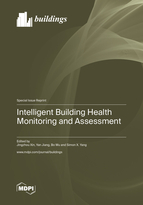Intelligent Building Health Monitoring and Assessment
A special issue of Buildings (ISSN 2075-5309). This special issue belongs to the section "Building Structures".
Deadline for manuscript submissions: closed (7 July 2023) | Viewed by 18617
Special Issue Editors
Interests: structural health monitoring; structural condition assessment; bridge engineering
Special Issues, Collections and Topics in MDPI journals
Interests: structural health monitoring; data analysis; stochastic process; load identification and localization; random fatigue; artificial intelligence; structural vulnerability
Special Issues, Collections and Topics in MDPI journals
Interests: structure condition assessment; structural health monitoring; structural vibration control; wind-induced vibration; signal processing techniques; computational mechanics
Special Issues, Collections and Topics in MDPI journals
Interests: artificial intelligence; robotics; sensors and multisensor fusion; wireless sensor networks; control systems; bio-inspired intelligence; machine learning; neural networks; fuzzy systems; computational neuroscience
Special Issues, Collections and Topics in MDPI journals
Special Issue Information
Dear Colleagues,
As the key nodes of the interoperability of traffic systems, bridges are essential for the development of the economy and for guaranteeing social safety. However, when their service years are extended, bridges inevitably suffer from performance deterioration. Performance monitoring and evaluations of a bridge are crucial during the whole life cycle of the bridge, as these checks provide vital scientific research significance and engineering application value for ensuring the safety of bridges and for keeping road networks unblocked. The accelerated integration and convergence of civil engineering, materials science, and artificial intelligence have inspired researchers from diversified disciplines to become interested in the challenges of the emerging bridge-state perception methods. Research on intelligent monitoring and assessment in building structures has made significant progress in both theoretical investigations and practical applications.
This Special Issue is devoted to the new research and development activities in regard to the intelligent monitoring and assessment of bridges. The focus of this Special Issue includes several theoretical and practical problems related to new discoveries, innovative ideas, and improvements in the intelligent monitoring and assessment of bridge health. The papers to be included in the Special Issue will cover a broad range of theoretical and applied topics of interest. The topics of this Special Issue include, but are not limited to, the following topics: structural health monitoring, nondestructive testing, artificial intelligence, damage identification, computer vision-based techniques, structure condition assessment, load identification, and data analysis.
Dr. Jingzhou Xin
Dr. Yan Jiang
Dr. Bo Wu
Prof. Dr. Simon X. Yang
Guest Editors
Manuscript Submission Information
Manuscripts should be submitted online at www.mdpi.com by registering and logging in to this website. Once you are registered, click here to go to the submission form. Manuscripts can be submitted until the deadline. All submissions that pass pre-check are peer-reviewed. Accepted papers will be published continuously in the journal (as soon as accepted) and will be listed together on the special issue website. Research articles, review articles as well as short communications are invited. For planned papers, a title and short abstract (about 100 words) can be sent to the Editorial Office for announcement on this website.
Submitted manuscripts should not have been published previously, nor be under consideration for publication elsewhere (except conference proceedings papers). All manuscripts are thoroughly refereed through a single-blind peer-review process. A guide for authors and other relevant information for submission of manuscripts is available on the Instructions for Authors page. Buildings is an international peer-reviewed open access monthly journal published by MDPI.
Please visit the Instructions for Authors page before submitting a manuscript. The Article Processing Charge (APC) for publication in this open access journal is 2600 CHF (Swiss Francs). Submitted papers should be well formatted and use good English. Authors may use MDPI's English editing service prior to publication or during author revisions.
Keywords
- bridge health monitoring
- bridge status assessment
- bridge structures
- artificial intelligence
- data analysis
- multisensor fusion









